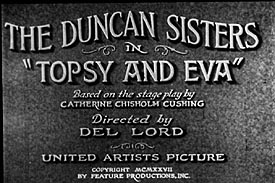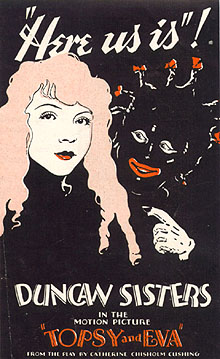The Duncan Sisters in "Topsy and Eva," Based on the Stage Play by Catherine Chisholm Cushing. Directed by Del Lord. United Artists Picture. Copyright 1927 by Feature Productions, Inc.
Supervisor, Myron Selznick. Settings by William Cameron Menzies. Photography, John N. Boyle. Continuity, Scott Darling.
|
 |
Comedy Constructor, Clarence Hennecke. Titles, Dudley Early. Technical Direction, Ned Herbert Mann. Interior Decorations, Casey Roberts. Wardrobe Management, Frank Donnellano. Costumes, Madame K. Keeler. Assistant Director, Bruce Humberstone. Film Editor, Hal C. Kern. Running time: 80 minutes.
The Players: Topsy, Rosetta Duncan. Eva, Vivian Duncan. George Shelby, Nils Asther. Mariette, Marjorie Daw. Simon Legree, Gibson Gowland. Aunt Ophelia, Myrtle Ferguson. St. Clare, Henry Victor. Uncle Tom, Noble Johnston.
|



